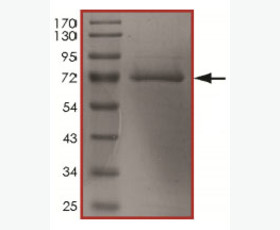Recombinant Human Peptidyl-Prolyl Cis-Trans Isomerase FKBP4/FKBP4
| Product name: | Recombinant Human Peptidyl-Prolyl Cis-Trans Isomerase FKBP4/FKBP4 |
| Source: | E. coli |
| Purity: | Greater than 95% as determined by reducing SDS-PAGE. |
| Buffer Formulation: | Supplied as a 0.2 μm filtered solution of 20mM Tris,10%glycerol, pH 8.0. |
| Applications: | Applications:SDS-PAGE; WB; ELISA; IP. |
| Storage: | Avoid repeated freeze/thaw cycles. Store at 2-8 oC for one month. Aliquot and store at -80 oC for 12 months. |
| UOM: | 100ug/50ug/200ug/1mg/1g |
| Source | E. coli |
| Description | Recombinant Human FKBP52 is produced by our E.coli expression system and the target gene encoding Met1-Ala459 is expressed with a 6His tag at the C-terminus. |
| Names | Peptidyl-prolyl cis-trans isomerase FKBP4, 51kDa FK506-binding protein, 51kDa FK506-binding protein, 59kDa immunophilin, FK506-binding protein 4, FKBP59, HSP-binding immunophilin, immunophilin FKBP52, Rotamase, FKBP4 |
| Accession # | Q02790 |
| Formulation | Supplied as a 0.2 μm filtered solution of 20mM Tris,10%glycerol, pH 8.0. |
| Shipping |
The product is shipped on dry ice/ice packs. |
| Storage |
Store at < -20°C, stable for 6 months after receipt. Please minimize freeze-thaw cycles. |
| Purity |
Greater than 95% as determined by reducing SDS-PAGE. |
| Endotoxin | Less than 0.1 ng/µg (1 IEU/µg) as determined by LAL test. |
| Amino Acid Sequence |
MTAEEMKATESGAQSAPLPMEGVDISPKQDEGVLKVIKREGTGTEMPMIGDRVFVHYTGWLLDGT KFDSSLDRKDKFSFDLGKGEVIKAWDIAIATMKVGEVCHITCKPEYAYGSAGSPPKIPPNATLVF EVELFEFKGEDLTEEEDGGIIRRIQTRGEGYAKPNEGAIVEVALEGYYKDKLFDQRELRFEIGEG ENLDLPYGLERAIQRMEKGEHSIVYLKPSYAFGSVGKEKFQIPPNAELKYELHLKSFEKAKESWE MNSEEKLEQSTIVKERGTVYFKEGKYKQALLQYKKIVSWLEYESSFSNEEAQKAQALRLASHLNL AMCHLKLQAFSAAIESCNKALELDSNNEKGLFRRGEAHLAVNDFELARADFQKVLQLYPNNKAAK TQLAVCQQRIRRQLAREKKLYANMFERLAEEENKAKAEASSGDHPTDTEMKEEQKSNTAGSQSQV ETEALEHHHHHH
|
| Background | FKBP4 act as a regulator of microtubule dynamics by inhibiting MAPT/TAU ability to promote microtubule assembly. FKBP4 may play a role in the intracellular trafficking of heterooligomeric forms of steroid hormone receptors between cytoplasm and nuclear compartments, it also may have a protective role against oxidative stress in mitochondria. The isomerase activity controls neuronal growth cones via regulation of TRPC1 channel opening. |














